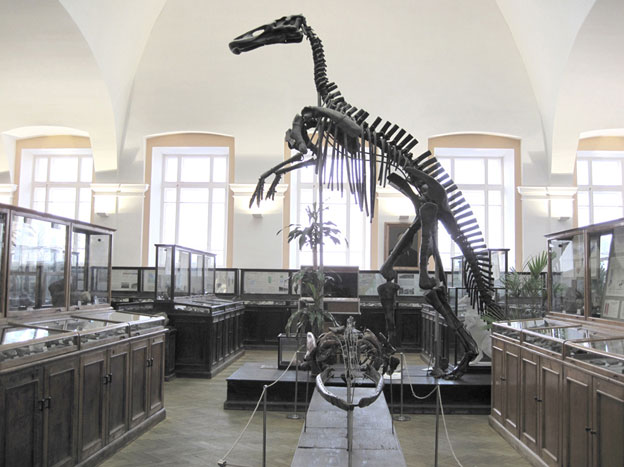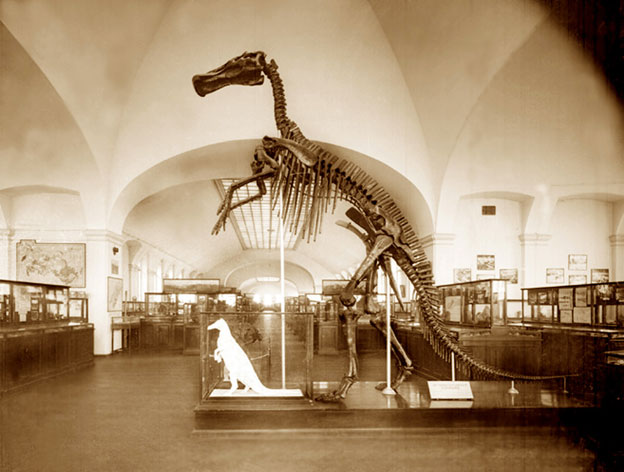The skeleton of the herbivorous duck-billed dinosaur Mandschurosaurus amurensis exhibited at the museum is about 4.5 m high and 8 m long. The jaws, resembling a duck's bill, are widened in front and were probably covered with a horn shell. The teeth are not preserved. Presumably, they were arranged brush-like in 35 grooves, in the mouth there were at least 800 teeth renewed when worn. Mandschurosaur had poorly developed forelimbs with four fingers and a probable webbing between them. The tail consisted of 70 vertebrae and served as a rudder when swimming, as well as a defence tool when attacked by predatory representatives of dinosaurs.


Skeleton of a duck-billed dinosaur in the Asia Hall of the Museum
These ancient reptiles reproduced by laying eggs in the sand. There are fossilized dinosaur eggs to 35 cm in diameter; finds of intact nests with eggs are known.
For the first time in the Amur region, dinosaur fossils were discovered by F.B. Schmidt in 1859 on the right bank of the Amur River (Belye Kruchi locality, Chinese name Longgushan, now Jiaying County, Heilongjiang Province, China), but taken for the bones of mammals.
This locality was discovered for the second time in 1902 by Colonel of the General Staff M.M. Manakin. His attention was drawn to the weights used by the Cossacks when fishing with nets. Upon examination, he was convinced that these were fossilized bone remains, which he attributed to mammoths, widely known from finds from Siberia. M.M. Manakin gathered a small collection of fossilized vertebrae and ribs, which were transferred to the Khabarovsk Museum of Natural History (now N.I. Grodekov Khabarovsk Regional Museum). In a document dated 15 July 1902, attached to the finds, addressed to the ataman of stanitsa Poyarkovskaya, he designated these items as “archaeological collections” that needed to be delivered to the city museum. Among them were “6 fragments from the bones of an unknown antediluvian animal, found in a sandy mountain eroded by water on the right bank of the river between the khutors of Kasatkino and Sagibovo.”
In 1902, Priamurskie Vedomosti and Amurskaya Gazeta reported on the discovery of a “skeleton of an antediluvian animal” on the right bank of the Amur (between Kasatkino and Sagibovo): “The bones lie in the bank stratum of the river. Resting on its ancient bank, consisting of a blue conglomerate, under a three-sazhen layer of alluvial sand, approximately at a height of two sazhens from the normal level. As far as can be judged from a hastily produced study, the skeleton lies on its left side, with its forelimbs turned towards the river, being to 5 sazhens long.
Newspaper notes also reported that the bone remains were discovered two years ago, they fell out of sediments in a steep bank washed away by the waters of the Amur.
In 1902, the Amur branch of the Imperial Russian Geographical Society sent G.F. Belousov for reconnaissance along the coast of the Middle Amur. He was accompanied by A.Ya. Gurov, who was working at that time on the instructions of the Blagoveshchensk Museum on an archaeological map of the Amur Region, in which he noted “the localities with the bones of antediluvian animals.” The researchers examined the locality with the skeleton of an unknown reptile, after which part of the bone remains was sent to the Khabarovsk Museum of Natural History. Subsequently, Gurov collected paleontological material here, bones washed out of the cliff.
In 1912, the Geological Committee began compiling a 10-verst map of the Russian Empire. The Far East was included in the general research plan. On the instructions of the Geological Committee, in 1914 Afrikan Nikolaevich Krishtofovich arrived in the Amur region. Gurov gave Krishtofovich fragments of fossil bones and information about their accumulation in the right-bank cliffs of the Belye Kruchi along the Amur River, near the Shirokaya Pad. Krishtofovich delivered the materials received from Gurov to the museum of the Geological Committee in Petrograd and handed them over to A.N. Ryabinin, who identified them as the tibia of a dinosaur. On his recommendation, the Geological Committee instructed V.P. Rengarten to investigate the dinosaurs bone remains on the Amur River. In the winter of 1915-1916, he examined the locality, recorded a sequence of the outcrop and collected fossil flora from the tuffs of Mount Sagibovsky Boguchan.
The data of preliminary studies allowed A.N. Ryabinin to apply to GeolCom with a proposal to send staff preparator N.P. Stepanov for paleontological excavations in the summer of 1916. He presented the results of the excavations on 13 January 1917 in the report “Dinosaurs from the Amur River” at the annual meeting of the Russian Paleontological Society.
The next step was to apply to the GeolCom Office with a proposal to schedule excavations on the Amur River, planned for two or three months, for 1917. This proposal of A.N. Ryabinin was presented to the Office by the GeolCom director K.I. Bogdanovich, who noted: “The initial excavations on the Amur River, produced in the summer of 1916 for 10 days by the preparation worker of the Geological Committee Stepanov in order to search for the remains of dinosaurs, delivered to the Committee such significant material that, on their basis, A.N. Ryabinin succeeded in determining the belonging of the remains to two types of dinosaurs (predators and herbivores) and raised the question of the desirability of mounting these remains in the Museum of the Geological Committee.”
The proposal was supported and paleontological work on the Amur River continued in the summer of 1917. The result of the excavations in 1916-1917 was the extraction of several “tens of poods (about 3,200 kg) of dinosaur bones.” Ryabinin presented preliminary conclusions based on the results of work with these materials in 1918. And, although expedition of the second year did not manage to find the missing parts of the dinosaur skeleton, the excavations were not continued due to a number of domestic and foreign political events in 1917-1922. Fossil bone materials were taken to Petrograd, for the years 1918-1923 they were dissected. But “to study the remains of an animal or animals, restore their skeleton from scattered parts in the fullest form and exhibit it in the Museum of the Geological Committee” became possible after a three-month trip to Germany, Belgium, England in 1924, which allowed him to compare the material taken from Amur region with that in the European museums.
After returning from a business trip (January 1925), together with N.P. Stepanov and sculptor Ya.M. Eglon, he set about restoring the dinosaur skeleton.

Mounting of the skeleton and mounted skeleton of Mandschurosaurus, 1925
In addition to the skeleton restoration, the external appearance of the animal was reconstructed from plaster, approximately 1/5 of the size of the skeleton.

Skeleton and reconstruction of Mandschurosaurus at the museum exhibition, 1927
At the open annual meeting on 1 February 1925, A.N. Ryabinin made a report, and then presented a reconstruction of the dinosaur skeleton, tentatively named Trachodon amurense sp. nov., at the GeolCom Museum. Later on (1930), the dinosaur was described as Mandschurosaurus amurensis.